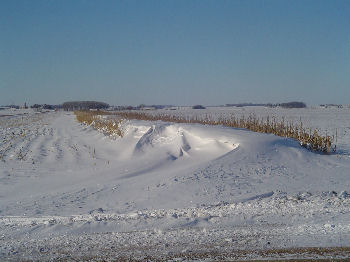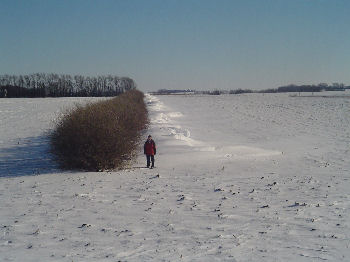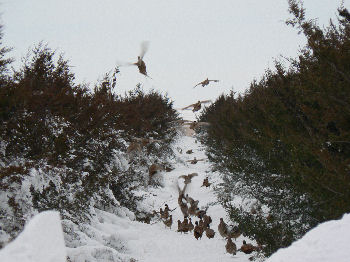Closed roads, reduced visibility, whiteout conditions, farmsteads without access to emergency services, travel delays, dumped milk, stranded motorists, schools closed. These are real challenges that affect all residents traveling and working through the winter season.

The Minnesota Living Snow Fence Program offers an environmentally sound solution for making transportation safer and more efficient during Minnesota winters. Living snow fences are designed plantings that create a vegetative barrier 150 to 300 feet from the highway right-of-way line to contain blowing and drifting snow. A high-density twin-shrub row that is 10 feet high is capable of capturing 24 tons of snow per lineal foot of snow fence. During an average winter a 1,000-foot-long high-density twin-shrub-row living snow fence can capture 224,000 tons of snow. This is snow that does not need to be touched by a snowplow.


Research shows benefits for agricultural regions
Scientific research supports the creation of living snow fences. "Recent winter field studies have shown that living snow fences can be a highly effective method of controlling blowing and drifting snow on Minnesota roads and highways," said Dr. Mark Seeley, a University of Minnesota climatologist. "University climate research shows that since pioneer settlement, most areas of the state are witnessing an increase in annual seasonal snowfall. In this context, it is imperative that some consideration be given to using living snow fences."
Living snow fences reduce wind speed and redirect the wind, thus improving driver visibility and road conditions. The wind action behind a living snow fence creates a region of turbulence and eddying approximately 10 times the height of the fence downwind that causes the snow to be sucked down in a vacuum-like manner and deposited away from the road. This is why living snow fences need to be placed somewhere between 150 to 300 feet upwind of the road, to avoid creating drifts on the driving lane.
The need for living snow fences is greatest in the agricultural regions of Minnesota, where open expanses of land create opportunities for the wind to pick up speed and carry with it tons of blowing and drifting snow. Although the fences generate public benefits, their placement frequently occurs on privately owned land. Consequently, living snow fence plantings require voluntary cooperation and participation from the farmer, along with special sensitivity in their promotion.


Program involves state, federal compensation for farmers
On July 16, 2002, Minnesota local, county, state, and federal officials announced the expansion of the Living Snow Fence Program to better connect with the farmers. This collaborative program pays farmers for designating part of their land for living snow fences under the Conservation Reserve Program (CRP), part of the 2002 federal Farm Bill plus receive payments from the Minnesota Department of Transportation (Mn/DOT). "Farmers can now receive payments under CRP as well as support from Mn/DOT for living snow fences, which save lives, money, and time by keeping highways open for travelers," said then Commissioner of Transportation Elwyn Tinklenberg. This new living snow fence partnership program is needed to coordinate the two diverse government incentive and cost-share programs currently in effect to encourage living snow fence planting.
The federal Conservation Reserve Program (CRP) is a voluntary program that offers annual rental payments, cost-share assistance, and incentives to establish long-term resource conservation on eligible land. The U.S. Department of Agriculture Farm Service Agency (FSA) is responsible for administering the Conservation Reserve Program. To be a participant in the living snow fence program, a farmer must be enrolled in the CP-17A Living Snow Fence Practice and the land must meet certain eligibility requirements. Annual rental payments to the farmer are based on the agriculture rental value of the land. The duration of the contracts ranges from 10 to 15 years.
Along state highways the Minnesota Department of Transportation (Mn/DOT) partners with FSA and annually compensates farmers for the inconvenience and lost efficiency of having to farm around a living snow fence. These sites are identified as problem snow and blowing snow site on MN highways. To ensure the fence remains healthy and vigorous, enabling it to perform its intended function, farmers also receive annual compensation for growing and maintaining the living snow fence. The duration of Mn/DOT's living snow fence contract ranges from 10 to 15 years. Since 2002 Mn/DOT has partnered with USDA, Soil and Water Conservation Districts (SWCD) and 29 private landowners to install nearly 10 miles of living snow fence. MnDOT also pays farmers to leave standing corn rows in the fall to protect sensitive MN state highways.
Coordinating both these government incentive and cost-share programs requires a joint effort by all parties to raise public awareness, create local living snow fence work groups, and maintain momentum so that communities will continue to support this effort for snow management.
For more information
Daniel Gullickson, MnDOT Forester, This email address is being protected from spambots. You need JavaScript enabled to view it.
Gary Wyatt, Extension Agroforester, This email address is being protected from spambots. You need JavaScript enabled to view it.
Diomy Zamora, Extension Agroforester, This email address is being protected from spambots. You need JavaScript enabled to view it.
If you would like to learn more about living snow fences and designing drift-free roads, visit www.dot.state.mn.us/environment/livingsnowfence/ This site has a direct link to agency partners and to the University of Minnesota winter climate web site.
By Daniel Gullickson, MnDOT Forester; Gary Wyatt, Extension Agroforester; and Diomy Zamora, Extension Agroforester. (Photos courtesy of University of Minnesota Extension)



